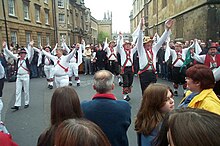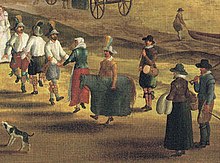 | |||
| |||
| |||
| |||

Suatu tarian morris adalah sebentuk tarian rakyat Inggeris biasanya ditemani dengan muzik. Ia berasas rentak berirama dan melaksanakan tokoh-tokoh koreograf oleh sekumpulan penari. Perkakas seperti kayu, pedang, sapu tangan dan loceng dapat juga digunakan oleh para penari. Dalam suatu bilangan kecil tarian untuk satu atau dua lelaki, langkah-langkah dipersembah berhampiran dangan di sepanjang sepasang paip tembakau tanah liat dibaring di sepanjang sesama sendiri di lantai.
Dakwaan bahawa rakaman Inggeris, bermula pada 1448, menyebut tarian morris terbuka pada pertikaian. Tiada sebutan tarian "morris" lebih awal dari lewat abad ke-15, walaupun rekod awal seperti Bishops' "Visitation Articles" menyebut tarian pedang, suatu pemuatan halaman istana, dan kedua-dua lelaki dan perempuan disebut menari, dan sedikit kemudian dalam Lord Mayors' Processions di London. Ia hanya kemudian bahawa ia bermula untuk menyebut sebagai suatu dipersembah di kariah. Sudah tentu tiada bukti yang ia adalah suatu upacara amal pra-Kristian, seperti ia sering didakwa.
Pada hari moden, ia adalah umum difikir sebagai aktiviti yang secara unik Inggeris, walaupun ada sekitar 150 tepi morris (atau pasukan) di Amerika Syarikat. Ekspatriat British membentuk suatu bahagian yang lebih besar tradisi morris di Australia, Kanada, New Zealand, dan Hong Kong. Ada kumpulan-kumpulan terpencil di negara-negara lain, contohnya mereka di Utrecht, Belanda, Arctic Morris Group of Helsinki[1] and Stockholm[2], dan jua di Cyprus dan Alsace, France.[3]
Asal-usul istilah

While there is still some dispute as to the origin of the term "Morris", the most widely accepted theory[perlu rujukan] is that the term was moorish dance, morisques in France, Moriskentanz in Germany, moreška in Croatia, and moresco, moresca or morisca in Italy and Spain, which eventually became morris dance.[4] Dances with similar names and some similar features are mentioned in Renaissance documents in France, Italy, Germany, Croatia, and Spain; throughout, in fact, Catholic Europe. This is hardly surprising; by 1492 Ferdinand of Aragon and Isabella of Castille succeeded in driving the Moors out of Spain and unifying the country. In celebration of this a pageant known as a Moresca was devised and performed. This can still be seen performed in places such as Ainsa, Aragon. Incorporated into this pageant was the local dance — the Paloteao. This too can still be seen performed in the villages of Aragon. The original ´Moresca´ is a sword dance. The sticks in Morris dance are a residual of the swords in the 'Moresca'. The similarity to what became known as the English "morris" is undoubted.[perlu rujukan] Early court records state that the "moresque" was performed at court in her honour, including the dance — the "moresque" or "morisce" or "morys" dance.
"Morris" is sometimes capitalized, though in this context it is not a proper noun.
Sejarah di England

Before the English Civil War, the working peasantry took part in morris dances, especially at Whitsun. In 1600 the Shakespearean actor William Kempe morris danced from London to Norwich, an event chronicled in his Nine Daies Wonder (1600). The Puritan government of Oliver Cromwell, however, suppressed Whitsun Ales and other such festivities. When the crown was restored by Charles II, the springtime festivals were restored. In particular, Whitsun Ales came to be celebrated on Whitsunday, as the date coincided with the birthday of Charles II.
Morris dancing continued in popularity until the industrial revolution and its accompanying social changes. Four teams claim a continuous lineage of tradition within their village or town: Abingdon (their morris team was kept going by the Hemmings Family),[5] Bampton, Headington Quarry, and Chipping Campden.[6] Other villages have revived their own traditions, and hundreds of other teams across the globe have adopted (and adapted) these traditions, or have created their own styles from the basic building blocks of morris stepping and figures.

Several English folklorists were responsible for recording and reviving the tradition in the early 20th century, often from a bare handful of surviving members of mid-19th-century village sides. Among these, the most notable are Cecil Sharp, Maud Karpeles, and Mary Neal.
Boxing Day 1899 is widely regarded as the starting point for the morris revival. Cecil Sharp was visiting at a friend's house in Headington, near Oxford, when the Headington Quarry morris side arrived to perform. Sharp was intrigued by the music and collected several tunes from the side's musician, William Kimber; not until about a decade later, however, did he begin collecting the dances, spurred and at first assisted by Mary Neal, a founder of the Espérance Club (a dressmaking co-operative and club for young working women in London), and Herbert MacIlwaine, musical director of the Espérance Club. Neal was looking for dances for her girls to perform, and so the first revival performance was by young women in London.

In the first few decades of the 20th century, several men's sides were formed, and in 1934 the Morris Ring was founded by six revival sides. In the 1960s and especially the 1960s, there was an explosion of new dance teams, some of them women's or mixed sides. At the time, there was often heated debate over the propriety and even legitimacy of women dancing the morris, even though there is evidence as far back as the 16th century that there were female morris dancers. There are now male, female and mixed sides to be found.
Partly because women's and mixed sides are not eligible for full membership of the Morris Ring, two other national (and international) bodies were formed, the Morris Federation and Open Morris. All three bodies provide communication, advice, insurance, instructionals (teaching sessions) and social and dancing opportunities to their members. The three bodies co-operate on some issues, while maintaining their distinct identities.
Lihat juga
| Wikimedia Commons mempunyai media berkaitan Tarian Morris di England |
- Ball de bastons
- Căluşari
- Tarian Kebangsaan Inggeris
- Maculelê (dance)
- Pipe and Tabor
- Tarian senjata
- Morris: A Life with Bells On
Nota
- ^ Helsinki Morrisers
- ^ [1]
- ^ Ferrette Morris Men
- ^ D. Arnold, The New Oxford Companion to Music, vol. 2 (Oxford University Press, 1983), p. 1203.
- ^ "Hemmings tradition". Diarkibkan daripada yang asal pada 2006-04-02. Dicapai pada 2010-11-03.
- ^ "Chipping Campden Morris Men | Homepage". Diarkibkan daripada yang asal pada 2007-02-08. Dicapai pada 2010-11-03.
Rujukan
- Forrest, John.The History of Morris Dancing, 1483-1750. Cambridge:James Clarke & Co Ltd, 1999.
Pautan luar
- Morrisbook Networking site for morris dancers
- Bordering on the Insane: Confessions of a Shropshire Bedlam by John Kirkpatrick Diarkibkan 2008-06-10 di Wayback Machine
- The Complete Morris On and Other Plain Capers
- The Morris Book A history of morris dancing by Cecil J. Sharp, from Project Gutenberg
- The Moreska Dance in Island Korcula, Croatia
- The Morrisdancing Page Links to morris sides and organizations
- Morris Dancing FAQs Diarkibkan 2008-06-12 di Wayback Machine Database of morris-related questions
- The Origins of Morris By Chris Farr of Dartington Morris Men
- The English Folk Dance and Song Society at Cecil Sharp House, London]
- From Ritual to Romance By Jesse L. Weston, at Project Gutenberg
- Goths and Pagans reinventing Morris Dancing (The Independent (UK), retrieved 11 May 2008)
- Morris dancing facing extinction (The Daily Telegraph (UK),
- Morris: A Life with Bells On IMDB article
- Welsh Morris
- “Everybody Dance Now!” an interview with London Morris Men
- MorrisDance.com
- Rencana Wikipedia yang memerlukan pembersihan selepas diterjemahkan
- Rencana Wikipedia yang memerlukan pembersihan selepas diterjemahkan daripada bahasa yang tidak diketahui
- Projek BukanTeamBiasa
- Semua rencana dengan kenyataan tidak bersumber dari January 2010
- Budaya rakyat Inggeris
- Mitologi Inggeris
- Muzik Inggeris
- Tarian










